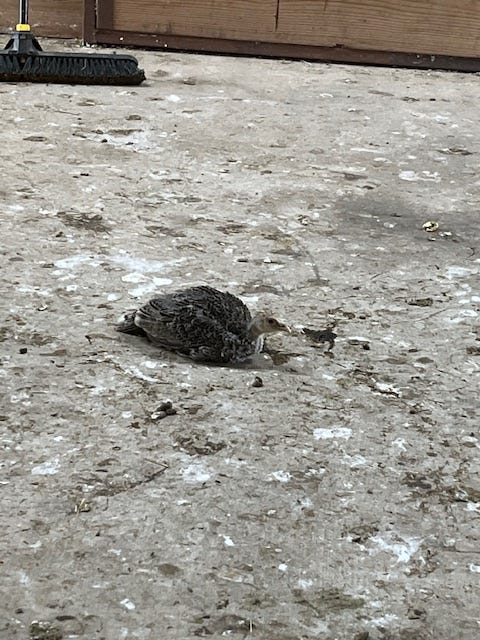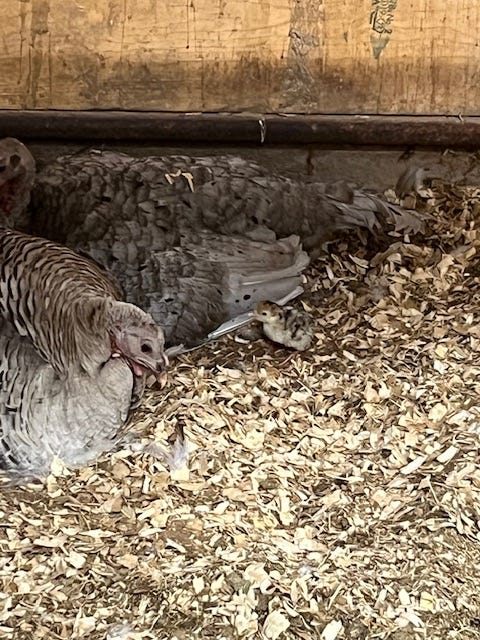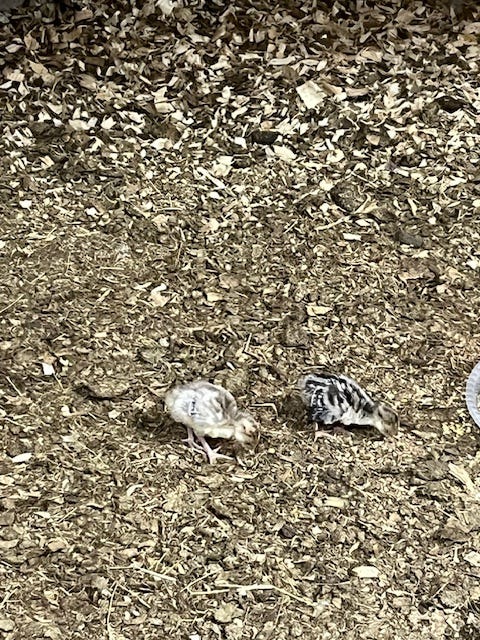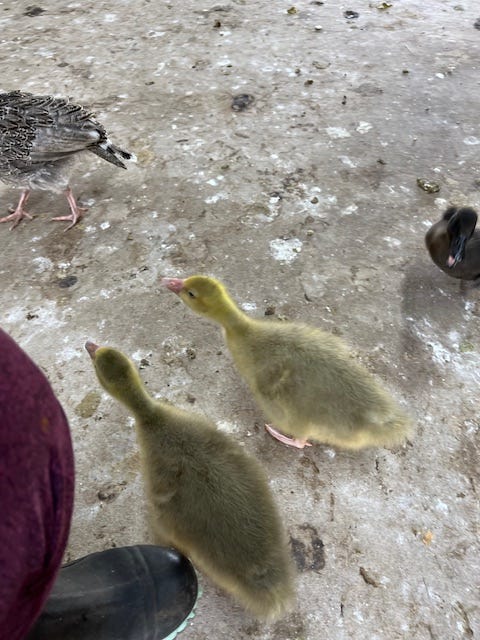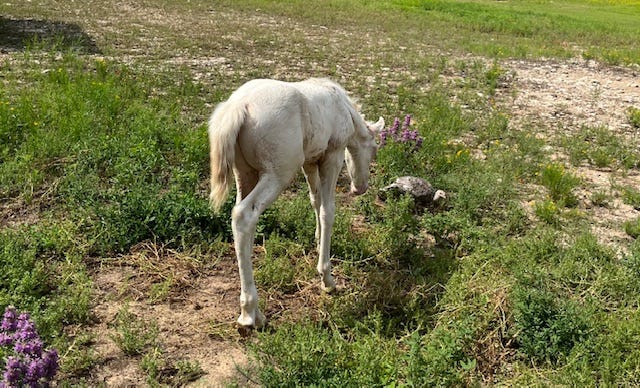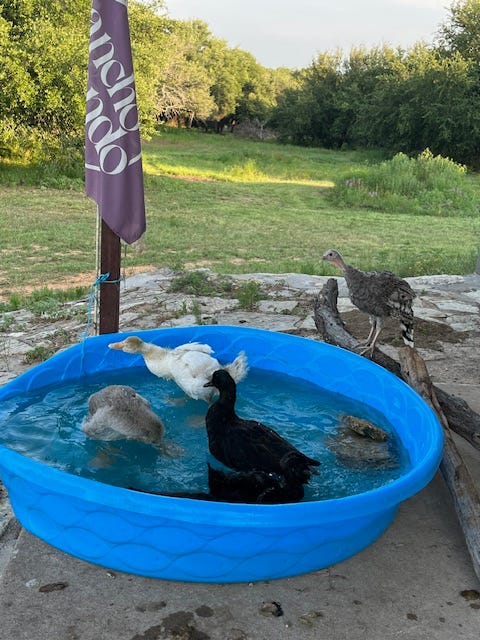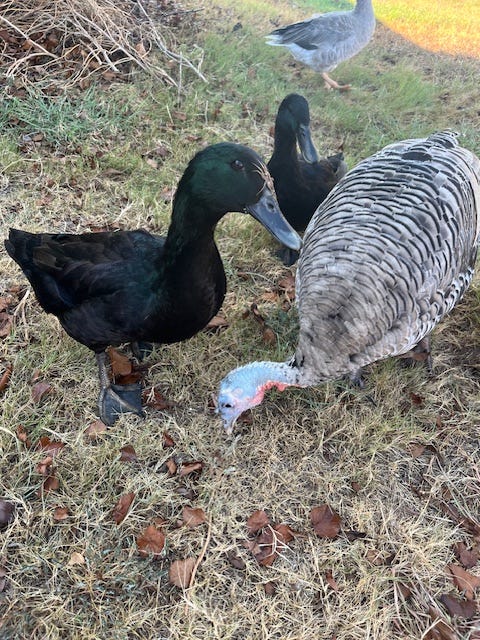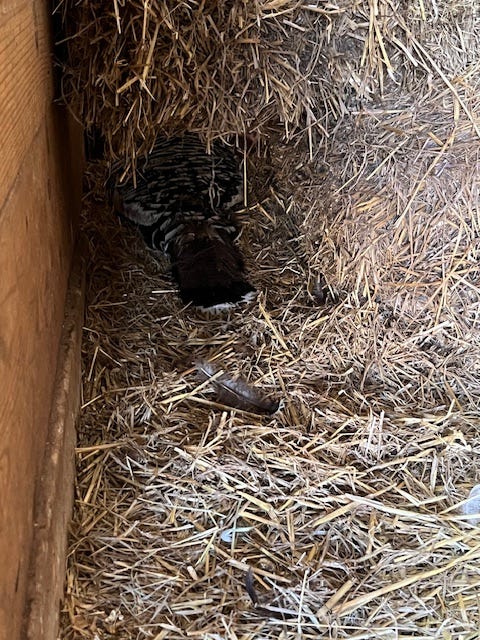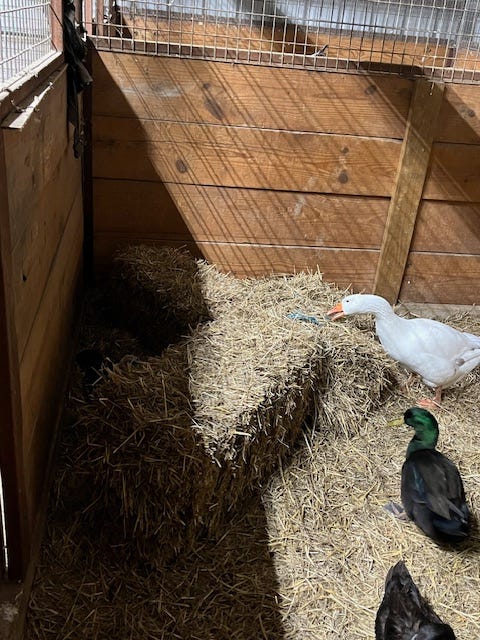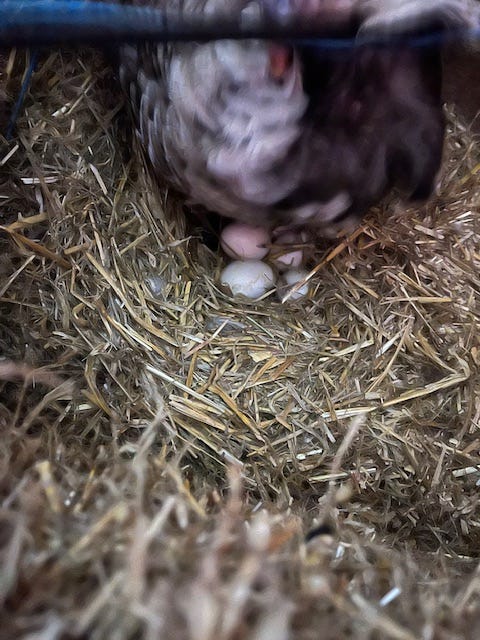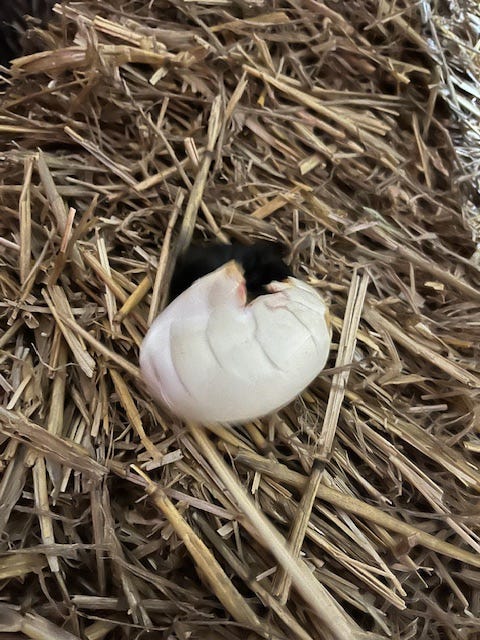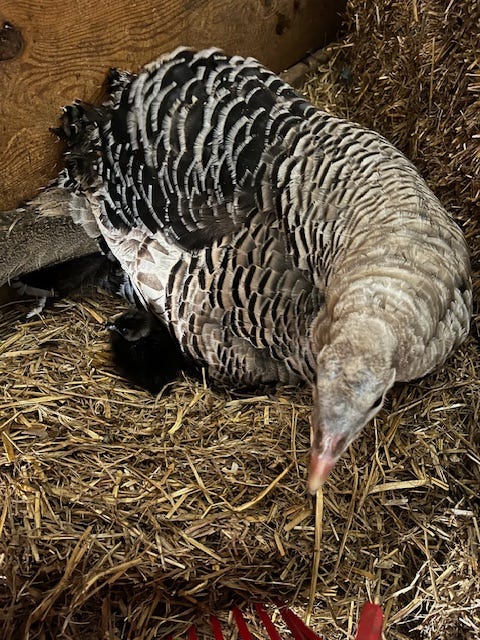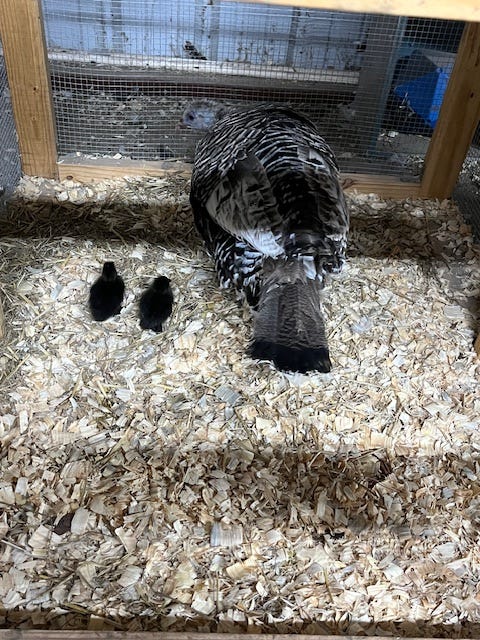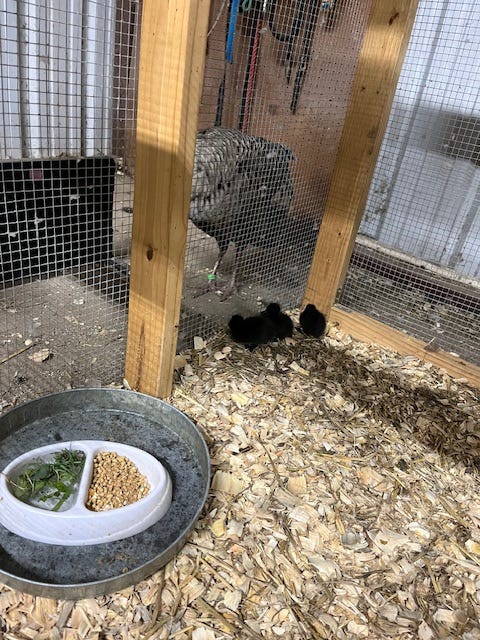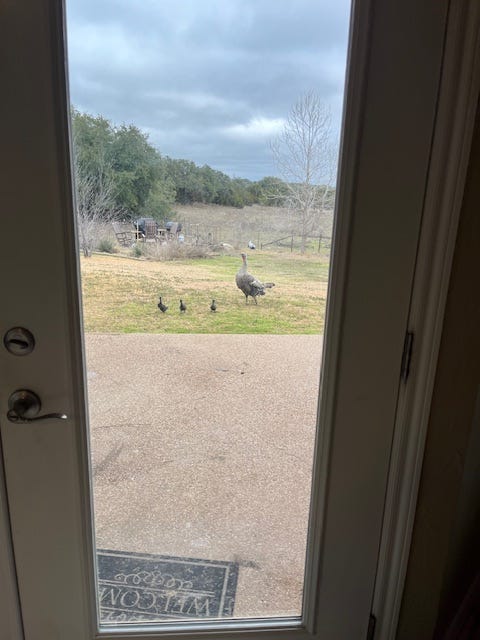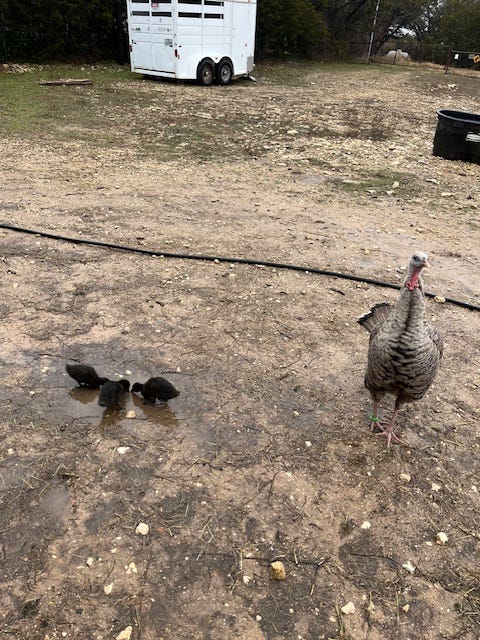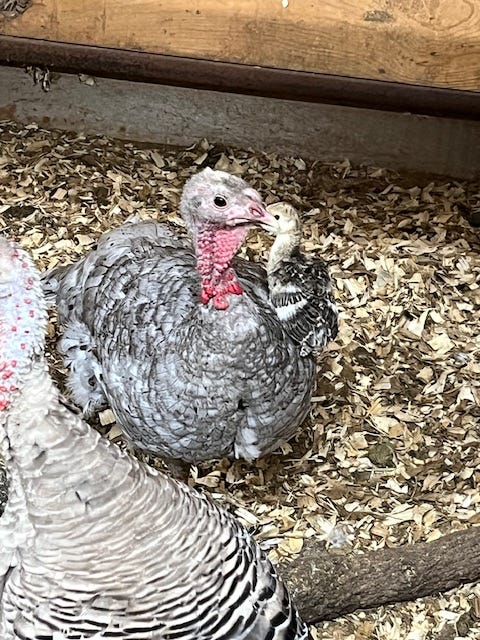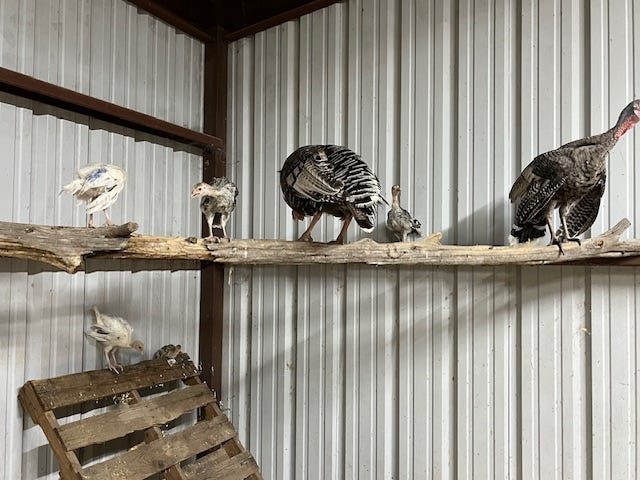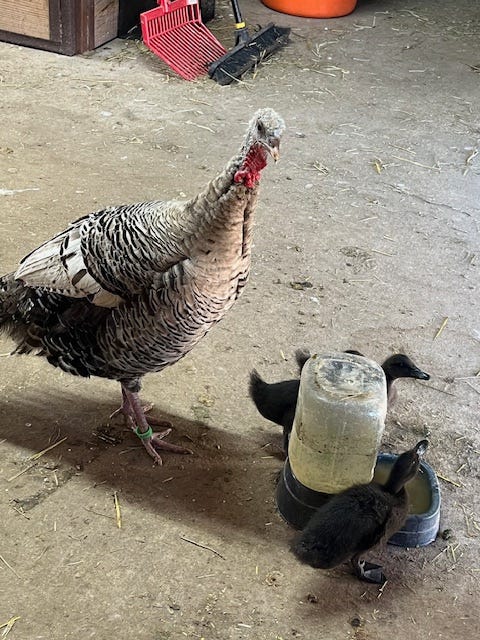Bob's hatching story
Turkey mom to ducklings
This is Bob.
She hatched April 8th, 2023. She was the first one to hatch from that clutch and, consistent with our theme for naming our turkeys, we named her Robert F. Kennedy, Jr. (first one to show). Obviously, at that point we didn’t know she was a she, but the name stuck. Fitting for her turkey family at the time: Dad Al, Mom Bill and Aunt Hilary (have you figured our theme out yet?)
She was joined a day later by Marj, who unfortunately was eaten by a snake (also fitting? You decide).
So Bob’s idyllic childhood “poulthood” was being raised by two doting and protective mothers. This lasted until Bill laid her second clutch of the year and was busy sitting and then raising her five siblings. It wasn’t planned for us to keep these turkeys, so our Hatch Batch theme for these was “Money Heist” and were named Río, Nairobi, Moscú, Tokyo and Denver. Bob was relegated to hanging out with our growing waterfowl flock of Cayuga ducks and Pilgrim geese. At first, the larger duck- and goslings bullied her away from food and water, but eventually she grew into herself and realized she could bully them instead!
When Bob began laying eggs at six months old, the ducks had already been laying for a few months and in a nice straw bale nest designed to keep the ducks laying in one place. I was allowing the eggs to collect instead of bringing them inside every day to see if one of my ducks would go broody and attempt to sit the eggs. Bob would also sneak in every other day or so and lay her own eggs in that nice nest.
When I was getting close to twenty mixed eggs, Bob decided she was going to sit the eggs and began by staying on the nest several hours every day. At night she flew up to the roost with the rest of the turkeys, but my duck Rayo would claim the nest overnight. After about three days like this, Bob refused to come off the nest during the day or night and spent the nights locked in the duck stall, sitting the eggs. None of the waterfowl would bother her, even though I had a suspicion that the ducks would climb over her to lay eggs or lay eggs near her that she would reach out and roll under herself. I monitored the nest as much as possible without disturbing Bob (when she occasionally got up to eat and stretch her legs, I would count and remove eggs if necessary).
After two weeks, I candled the eggs at night (better visibility and less of a disturbance to Bob) and removed any that weren’t developing. The sheer number of eggs needed to be reduced to help increase the hatch rate and prevent rotten egg bombs.
When hatching time approached, Bob was on about seven duck eggs - all that developed from the original mixed batch of eggs. She was extremely protective of the nest and eggs, fluffing up her feathers and chortling if anything came close. I had to use a horse whip as a shield to lift her enough to check the eggs without getting pecked and happened to see a little black ball of fluff! This was our first hatchling, the Intrepid (Hatch Batch theme: pirate ships). Over the next few days, only two other eggs were viable and I moved those to my incubator to finish hatching since Bob had soiled the nest and Intrepid needed to start eating.
The Black Pearl hatched three days later and joined its sibling the next morning.
And last, six days after the first hatch, the Queen Anne’s Revenge hatched. I would let the hatchlings spend the night in the incubator and would take them out to join their family the next morning. I did not want to raise the ducklings myself inside and wanted to give Bob the best chance of mothering during this experiment. Every time she would examine the new hatchlings as if wondering how they had magically multiplied, but was incredibly accepting and protective of every one. Like turkeys and waterfowl alike, they had to quickly learn to snuggle under mom for warmth and safety. I had moved Bob and ducklings to their own hardware mesh box outside of the stall but inside the barn for safety and privacy with their own food, water and greens.
The ducklings are now over a month old and Bob only recently (about a week now) decided to sleep at nights on the roost, the ducks go into the box to sleep and I close the door. During the day and free ranging, Bob still watches over the ducks, mostly hanging out with the turkeys. The turkeys are tolerant and accepting of the duckies, whereas the geese chase the duckies until Bob chases them. The duckies bravely chase their real mother, Rayo, knowing that Bob is there as a bodyguard.
There were three concerns for me with a turkey mom raising ducks and this experience has been informative. None of the three concerns end up being a dealbreaker for this experiment, but I believe it’s a credit mostly to Bob’s mothering abilities.
One: Would Bob be able to protect ducklings from predators while tolerating their love for water? Despite warnings not to let ducklings “swim” before proper feathering, I have not been able to keep my days old Cayugas out of their water. This goes for both naturally and artificially raised ducklings. I have learned to adapt to it and adjust their water and food setup accordingly. I start with small dishes inside larger shallow ones to contain the mess, eventually move those outside of their sleeping area and increasing in diameter and depth. At around a month old, the Cayugas can get in and out of the rubber horse bowls with water, but not the kiddie pool I have for the waterfowl with rocks in and around it (yet-they will be able to soon). Bob stays nearby while they swim and play and keeps the waterfowl away from the ducklings, but she is not concerned by their water-loving behaviors.
For predators, turkeys have several warning sounds or calls they use - one for “snake” (persistent high-pitched peeps) and one for “hawk” (a nasal whine if it’s far away and needs observing and an urgent chortle that means take cover immediately). Obviously, Bob using the turkey group to help babysit the ducklings is advantageous because more eyes are on the sky and the babies at the same time. A turkey hen raising poults will use the hawk call and the poults will hide if possible, flattening themselves against the ground and staying perfectly still. Their speckled poult feathers help provide camouflage along with perfect stillness. They don’t run to hide under the hen, in case she needs to jump or run to attack and fend off the predator and only when she gives the signal do they get up and continue their business. In Bob’s case, I only observed her using the hawk call with her ducklings and they responded the way ducks do to predators. So they understood the call, but responded by standing upright as much as possible to see the best and in a clustered group, also perfectly still. It will be interesting in the future to see where this group of ducks decides to spend its time, especially as breeding and egg laying behaviors emerge - with their turkey godfamily or with the waterfowl.
Two: sleeping habits. With my turkey poults, I add low sticks or perches to their stall so they can begin practicing jumping and perching behaviors. They also practice on their own moms, on the ground or even way up on the roost.
Eventually the poults can sleep on the same height roost as the adults with the help of stairs of sorts (a leaning pallet).
Ducks only sleep on the ground or floating on water if it’s available. Some evenings Bob would fly up to the roost and the ducklings would run around below, confused. But after I herded them into their box, Bob would make sure to come into the box as well and I would close the door. Only after the ducklings were about a month old, they would put themselves into the box, Bob would fly up to the roost, and I would close the door. By this point the ducks keep themselves warm at night and Bob will still protect them while ranging during the day.
Three: dust baths. I honestly forgot about this detail while considering the feasibility of turkeys raising ducks. A few afternoons ago, the turkey toms had spent all morning fighting while the hens decided to have a dust bath party under the cedar trees. Either brush pile ashes or the moist decaying needles and dirt under the cedars are their favorite dust bath spots. Group baths are the best, since multiple flapping wings can raise quite a dust cloud and get all of those hard to reach places. The ducklings during this whole process were clustered in a group nearby, but not taking part.
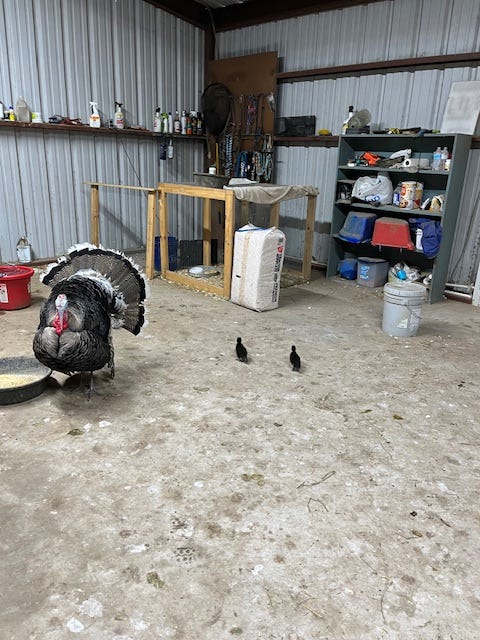
So, would I repeat this experience again? Yes, but credit to Bob’s mothering abilities which I would like for her to apply to raising turkeys or perhaps goslings, instead of ducks. None of my observations were a dealbreaker for her as a mom to ducklings and it kept me from having to brood babies inside. What is helpful is a similar hatch time for turkeys and waterfowl (28+ days), but the broody mom still has to recover physically from sitting and not eating properly during that time. At least in this case, ducklings develop so much faster than turkey poults that Bob has been able to eat and exercise a lot to quickly get back in form.
Bob is not yet a year old and considering her skill at mothering, I’m excited to see what our next hatching experiment will involve!
2025 update: Bob hatched out Buff duck Couscous in July 2024 along with some of her own turkey poults. I only kept Cous to try and see if she could be taught mothering by the Pro and because female Buffs fit nicely into my duck color project. The Black Pearl was a drake and ended up going to a new flock. I kept Intrepid & Revenge for several months, but then they went to a new flock as well.
Bob has not been able to steal any duck nests currently, but has been laying her own eggs in the pasture where she can’t brood. Once she finds or makes a nest inside the barn, I’ll allow her to brood again because she is such a great mom.



